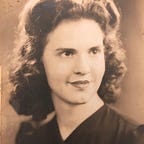The Feminine Lube Do-It-Yourselfer
The Haven interrupts its regular publishing to mark the death of someone who helped thousands of women reduce the friction in their lives: Miss Alzbeta Filomena Janacek, chemistry set lube guru.
Miss Janacek was a high school chemistry teacher on the Leelanau, a sparsely-populated peninsula in Michigan’s Up North known for cherry orchards, natural beauty, and the highest scenic overlooks on Lake Michigan. In 1974, she was wrestling with a problem: how to get girls interested in chemistry. Her solution: get their moms to set an example by doing chemistry at home.
Most moms had the means to be cottage chemists: their sons’ chemistry sets — large, boxed kits containing labware, chemicals, and instructions for conducting experiments. They were designed to let kids play with chemistry in ways which were entertaining, safe, and most of all, educational. And they’d proved popular on the Leelanau: by the ’70s, thousands of boys had used Chemcraft or Gilbert chemistry sets to play mad scientist in basement laboratories.
Miss Janacek planned to interest the moms by showing them how to make their own bath and body concoctions — ones which would cleanse, exfoliate, moisturize, tighten, and brighten their skin better than any commercial product.
To that end, she hosted chemistry set socials in her home. She invited eight moms at a time. Set out spreads of coffee, tea, and her killer carrot cake. Started with light-hearted socializing. Then showed the moms what could be done with their kids’ chemistry sets.
She familiarized them with the labware: the test tubes, beakers, and Erlenmeyer flasks; stoppers, rubber tubing, and Pinchcock clamps; the 24-inch rod stand with universal clamps; the ethyl alcohol burner; the graduated cylinder; and wraparound safety glasses and chemical-resistant gloves.
Then she showed the moms what they had to work with. No, not the chemicals which came with each set: the four-ounce bottles of acetates, bromides, and borates; chlorides, dioxides, and carbonates; glycols, glycerols, and propanols; and nitrates, glutamates, and permanganates. Miss Janacek advised the moms to donate those to her chemistry class.
Instead, Miss Janacek brought out substances suited to making creams, lotions, bath gels and beauty masks. Argan oil, echinacea, Hinoki oil, and ginseng. Gingko, lotus white, and milk thistle. Buckthorn berry, cubeb berry, and jojoba seed. And an ample supply of neutral face cream and hydrogel with which to mix them.
The moms, however, had another idea: they wanted to make lube. It was understandable. Off-the-shelf lubes were thick and goopy. They contained glycols, glycerols, and parabens — chemicals no prudent woman wanted anywhere near her lady parts. And they hated buying lubes at the grocery: every time they did, it was a public admission — to the cashier, the bag boy, the customers in line behind them — that they were “doing it.”
The alternative, going lube-less, wasn’t an option. Boys and toys created friction. And going sex-less was no option either. Leelanau women were frisky. Especially the ethnic Bohemians — the descendants of nineteenth century immigrants from what is now the Czech Republic, of whom Miss Janacek was one: even into their sixties, they were “zdravý a nadržený” (hale and horny). And though devout Catholics, they were far from nuns.
Problem was, do-it-yourself lubing was tricky. Make a lube too thin, and it was apt to spatter. And coital partners couldn’t stay connected; inevitably, one would step on the gas or misjudge a turn, and both would go skidding out of control. Making a lube too thick was also a problem: during the average mattress dance, body heat and friction turned the lube to grease, then paste. One moment, the partners would be struggling; the next, they’d seize up and get stuck. None of those things should happen with lubes which were tested. But DIY lubers didn’t test; not even a “dry run.”
Fortunately, Miss Janacek supplied the chemistry expertise to steer the moms around these pitfalls, and create lubes tailored to meet their personal needs.
Even better, she launched an activity which allowed them to develop and share their lubecraft amongst themselves: the Tupperware lube party. No, these weren’t for selling food containers. They were used by women to show off and exchange learnings about their homemade lubes. (The Tupperware’s role was just to carry them.)
Lube parties gave women a chance to hang out with friends over coffee and crumb cake. Catch up on what was happening in each others‘ lives. Exchange crafting ideas. Seek babysitter recommendations. Discuss problem behaviors by toddlers and husbands. And talk lube. Discuss novel ingredients, recent experiments, and the results of bench tests and human trials. Sniff, taste, and finger each others’ creations. Borrow samples for field tests at home. Swap recipes on 3x5 cards. And trade war stories about each others’ slippery triumphs and greasy blunders: the silky booyahs and messy boo-boos; the buttery successes and icky face-plants; the long-lasting coatings; the one-slide-wonders.
Thanks to Miss Janacek, Tupperware lube parties are now a fixture on Leelanau women’s social calendars. They’re considered valuable opportunities to connect with fellow chemistry set lubers. To pursue a passion characterized by ardent experimentation and stimulating give-and-take. And to expand what is now acknowledged to be a singularly satisfying field of science. (That said, lube parties, while more popular than other social calendar staples — knitting slams, quilting flash mobs, and Read-No-One-Ever book clubs — still can’t compete with ice fishing, smelt dipping, deer hunting, and of course, euchre.)
For her part, Miss Janacek, too, was an accomplished DIY luber. Indeed, only last year, her coconut oil lube won “Best in Glide” at the Michigan State Fair. And, as it happened, in cooking categories as well: she won blue ribbons for her Key Lime Coconut Lube pie, Coconut Lube No-Bake Brownies, Vinegar and Lube salad dressing, and Coconut Lube Kettle Corn.
